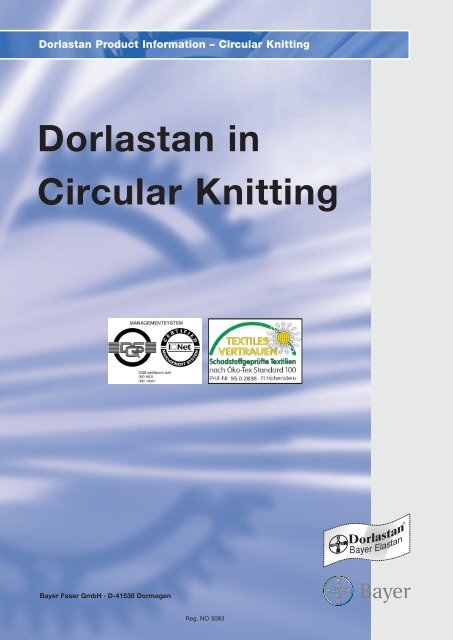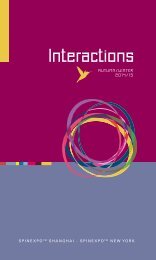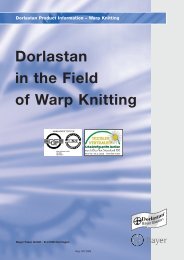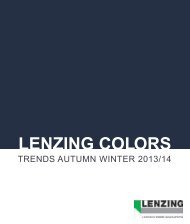Dorlastan in Circular Knitting - Fashion Trendsetter
Dorlastan in Circular Knitting - Fashion Trendsetter
Dorlastan in Circular Knitting - Fashion Trendsetter
You also want an ePaper? Increase the reach of your titles
YUMPU automatically turns print PDFs into web optimized ePapers that Google loves.
<strong>Dorlastan</strong> Product Information – <strong>Circular</strong> Knitt<strong>in</strong>g2.2 Elastane feed systemsPositive feed mechanisms where the unw<strong>in</strong>d<strong>in</strong>g elastane bobb<strong>in</strong> is driven havebecome the most common feed systems <strong>in</strong> large-diameter circular knitt<strong>in</strong>g whenprocess<strong>in</strong>g elastane yarn.The <strong>Dorlastan</strong> bobb<strong>in</strong> is driven positively <strong>in</strong> these delivery systems (e.g.Memm<strong>in</strong>ger elastane feeder MER). The <strong>Dorlastan</strong> bobb<strong>in</strong>s are placed on ahorizontal pair of rollers and pressed aga<strong>in</strong>st it only by their weight. The twoparallel rollers are driven at the same speed. The device can be stocked with upto four 58 mm bobb<strong>in</strong>s or two 115 mm bobb<strong>in</strong>s. After unw<strong>in</strong>d<strong>in</strong>g, the thread ispasses through an electric stopp<strong>in</strong>g device and is then fed directly to the needle.Up to 4 systems/workplaces may be served us<strong>in</strong>g one feeder. Multiple positivefeed devices are driven at identical speed via a drive belt, the speed of which iscontrolled by an adjustable width pulley. Adjustment of the pulley can vary thelet off speed of the positive feeders with respect to the knitt<strong>in</strong>g mach<strong>in</strong>e, whichallows precise control of the elastane tension dur<strong>in</strong>g the knitt<strong>in</strong>g process.2.3 Changes <strong>in</strong> yarn directionWhen process<strong>in</strong>g bare elastane it is even more essential to avoid unnecessarychanges <strong>in</strong> yarn direction than it is with conventional yarns. Otherwise uncontrolledvariations <strong>in</strong> tension may occur, which may lead to irregularities <strong>in</strong> the fabric, or even<strong>in</strong> thread breakage. Conical rolls which can be adjusted to precisely align theelastane yarn path have proven to be best suited for changes <strong>in</strong> the yarn direction.2.4 Loop formation and plat<strong>in</strong>gIf bare <strong>Dorlastan</strong> is processed to form a loop it must always be knitted togetherwith a ground yarn. This measure is necessary because there is the risk that the<strong>Dorlastan</strong> thread may break if the knitted fabric is stretched too far. Experiencehas shown that when work<strong>in</strong>g with <strong>Dorlastan</strong> dtex 44 a ground thread with atiter of at least 44 dtx should be used at the same time. Normally, <strong>Dorlastan</strong> isprocessed with the ground yarn us<strong>in</strong>g the plat<strong>in</strong>g technique.Plat<strong>in</strong>g means the simultaneous formation of one loop from two threads, so thatone thread will lie on the face of the fabric while the other thread is fed to theneedles <strong>in</strong> such a way that it forms the back or reverse of the f<strong>in</strong>al fabric.In the case of s<strong>in</strong>gle-bed circular knitt<strong>in</strong>g mach<strong>in</strong>es the <strong>Dorlastan</strong> must alwaysbe fed <strong>in</strong> via a plat<strong>in</strong>g thread guide.In the case of double-bed mach<strong>in</strong>es (ribb<strong>in</strong>g technique or <strong>in</strong>terlock technique),the thread guide can be omitted, if the delayed tim<strong>in</strong>g knitt<strong>in</strong>g technique(Figure 1) is applied: the <strong>Dorlastan</strong> is fed immediately to the dial needles viaa guide roller.4
<strong>Dorlastan</strong> Product Information – <strong>Circular</strong> Knitt<strong>in</strong>gSimultaneous yarn feedPath of the needle withdelayed yarn feedLoop form<strong>in</strong>g po<strong>in</strong>tLoop form<strong>in</strong>g po<strong>in</strong>tFigure 1: Path of the needle <strong>in</strong> the delayed tim<strong>in</strong>g knitt<strong>in</strong>g techniqueWhen the delayed tim<strong>in</strong>g knitt<strong>in</strong>g technique is applied, the dial of the circularknitt<strong>in</strong>g mach<strong>in</strong>e is adjusted <strong>in</strong> such a way that its needles s<strong>in</strong>k the loop laterthan the needles of the cyl<strong>in</strong>der. This changed sett<strong>in</strong>g makes it possible to threadthe <strong>Dorlastan</strong> yarn only <strong>in</strong>to the needles of the dial and to knit it <strong>in</strong> us<strong>in</strong>g theplat<strong>in</strong>g technique.2.5 Sett<strong>in</strong>g of the desired qualityKnitt<strong>in</strong>g articles can have three different types of elasticity:– longitud<strong>in</strong>al elasticity– transverse elasticity– two-way stretch (bielastic)The desired type of fabric can be achieved by choos<strong>in</strong>g the appropriate knitt<strong>in</strong>gmach<strong>in</strong>e (s<strong>in</strong>gle- or double-knit), knitt<strong>in</strong>g construction and determ<strong>in</strong><strong>in</strong>g the yarnfeed (e.g. every 2nd system knits <strong>Dorlastan</strong> <strong>in</strong> addition to the ground thread).If <strong>Dorlastan</strong> is <strong>in</strong>corporated <strong>in</strong> a rib construction, the f<strong>in</strong>ished fabric will havema<strong>in</strong>ly longitud<strong>in</strong>al elasticity. Articles with predom<strong>in</strong>antly transverse elasticity areobta<strong>in</strong>ed with double-knits by feed<strong>in</strong>g <strong>Dorlastan</strong> either to the dial needles only orto the cyl<strong>in</strong>der needles only. Bielastic articles are preferably produced as s<strong>in</strong>gleknits. When us<strong>in</strong>g <strong>Dorlastan</strong> with each knitt<strong>in</strong>g system, nearly identical elasticityand recovery force can be achieved for the longitud<strong>in</strong>al and the transversedirection.S<strong>in</strong>ce fabrics conta<strong>in</strong><strong>in</strong>g <strong>Dorlastan</strong> are expected to have higher extensibility andgreater recovery forces, it is necessary to set larger stitches. In addition, a muchf<strong>in</strong>er ground yarn is normally used. If the fabric is knit too tight (with very smallstitches or too thick ground yarn) the <strong>Dorlastan</strong> yarn is prevented from contract<strong>in</strong>gthe fabric to the desired extent.5
<strong>Dorlastan</strong> Product Information – <strong>Circular</strong> Knitt<strong>in</strong>g2.7 Process<strong>in</strong>g of elastic comb<strong>in</strong>ation yarnsComb<strong>in</strong>ation yarns are generally only used today if no suitable feed devices areavailable for process<strong>in</strong>g bare elastane.Comb<strong>in</strong>ation yarns are preferably used for knitt<strong>in</strong>g constructions where theelastane yarn lies on the surface, as here the possibilities for a bare process<strong>in</strong>gof elastane are still very limited.3. End UsesUp to now the use of <strong>Dorlastan</strong> <strong>in</strong> circular knitt<strong>in</strong>g has been considered from atechnical po<strong>in</strong>t of view. Let us now turn our attention to the knitted articlesthemselves. Given the large variety of end uses, it appears to be recommendedto dist<strong>in</strong>guish between the various sectors of use accord<strong>in</strong>g to the articleproperties desired. The ma<strong>in</strong> fields of application are:3.1 „Power Stretch“ articles3.2 Trouser material qualities3.3 Outer wear3.4 Swimwear3.5 Sportswear3.6 Body l<strong>in</strong>en3.7 Waistbands for underwear3.8 WeltsThe articles of these different sectors all have their specific properties. Due tothe <strong>in</strong>fluence of fashion on the numerous fields of use of knitted fabrics theboundaries between the various sectors are flexible, e.g. body l<strong>in</strong>en – <strong>in</strong>doorwear – nightwear (color – style).3.1 „Power-Stretch“ articlesFor articles with shap<strong>in</strong>g properties like corsetry, <strong>Dorlastan</strong> yarns of medium tocoarse range, i.e. approx. 133 dtex and above are required. Such articles needhigh recovery forces <strong>in</strong> both longitud<strong>in</strong>al and transverse directions. However,normally, the longitud<strong>in</strong>al extensibility need nor necessarily be as good as thetransverse one.Example 1:Highly-functional fabric made of a uniform ground yarn with <strong>Dorlastan</strong> plat<strong>in</strong>g ofevery stitch course.Mach<strong>in</strong>e: S<strong>in</strong>gle-knitGauge: 18 EMaterial: Polyamide dtex 78 f 68 x 2<strong>Dorlastan</strong> dtex 133Construction: RL plat<strong>in</strong>g of every stitch course7
<strong>Dorlastan</strong> Product Information – <strong>Circular</strong> Knitt<strong>in</strong>g3.2 Trouser Material qualitiesTrouser fabrics, e.g. for rid<strong>in</strong>g, require little extensibility of approx. 20–30% but ahigh degree of elasticity <strong>in</strong> both longitud<strong>in</strong>al and transverse directions to preventthem from becom<strong>in</strong>g baggy.Good longitud<strong>in</strong>al extensibility is obta<strong>in</strong>ed by knitt<strong>in</strong>g <strong>Dorlastan</strong> – together withthe ground yarn <strong>in</strong> a rib course.Example 2:Ribbed fabricMach<strong>in</strong>e: InterribGauge: 18 EMaterial: PA dtex 156 f 34<strong>Dorlastan</strong> dtex 44Construction: Ottoman3.3 Outer wearElastic qualities are also used to a large extent <strong>in</strong> outer wear. The yarn <strong>in</strong>sert ishighly varied <strong>in</strong> the hard fiber yarns used. The customary extensibilities for thisarea of use are achieved by us<strong>in</strong>g <strong>Dorlastan</strong> 22 – 44 dtex.Example 3:Longitud<strong>in</strong>al and transversal elastic quality with <strong>in</strong>novative PA yarn.Mach<strong>in</strong>e: S<strong>in</strong>gle-knitGauge: 28 EMaterial: Meryl Sat<strong>in</strong>é dtex 88 f 40Construction: RL plat<strong>in</strong>g of every stitch course3.4 SwimwearFabrics with high extensibility <strong>in</strong> longitud<strong>in</strong>al and transverse directions arerequired <strong>in</strong> this sector.They must be stretchable by 100% <strong>in</strong> both directions. Other qualitycharacteristics are:– average recovery force<strong>in</strong> general, fabrics are used that do not have any figure-shap<strong>in</strong>g properties.– different weightsThe weight ranges from between 100 and 200 g/m 2 depend<strong>in</strong>g on the f<strong>in</strong>aluse, e.g. swimwear for competitions, leisure swimwear or beachwear.8
<strong>Dorlastan</strong> Product Information – <strong>Circular</strong> Knitt<strong>in</strong>gIn the case of lightweight fabrics, these requirements can be met by us<strong>in</strong>g<strong>Dorlastan</strong> 44 dtex with profiled, bright polyamide filament yarn of 78 dtex be<strong>in</strong>gknitted <strong>in</strong> simultaneously as ground yarn. Higher weights of less transparencyand simultaneous support<strong>in</strong>g properties are obta<strong>in</strong>ed with <strong>Dorlastan</strong> 78 dtex andwith textured polyamide filament yarn.Example 4:Longitud<strong>in</strong>al and transversal elastic quality with low weightMach<strong>in</strong>e: S<strong>in</strong>gle-knitGauge: 28 EMaterial: PA filament yarn 78 dtex f 20 x 1<strong>Dorlastan</strong> dtex 44 or 78Construction: RL plat<strong>in</strong>g of every stitch course3.5 SportswearSports vests, tra<strong>in</strong><strong>in</strong>g and gymnastic suits require absorbent yarns such as cotton.S<strong>in</strong>ce spun yarns produce higher frictional forces at the po<strong>in</strong>ts of <strong>in</strong>tersection(needle and s<strong>in</strong>ker loop), however higher recovery forces are needed to overcomethem. We recommend plat<strong>in</strong>g <strong>in</strong> all courses with <strong>Dorlastan</strong> 33-78 dtex for s<strong>in</strong>gleknitfabrics. If the color turns out too dull, it can be improved by the additional useof a bright textured yarn.Example 5:Functional fabric for tra<strong>in</strong><strong>in</strong>gMach<strong>in</strong>e: <strong>Circular</strong> knitGauge: 28 EMaterial: PA 6.6 dtex 110 f 96<strong>Dorlastan</strong> 33 dtexConstruction: RL plat<strong>in</strong>g <strong>in</strong> all coursesFunctional wearWhen us<strong>in</strong>g a great deal of physical effort people beg<strong>in</strong> to sweat <strong>in</strong> order to coolthe body down by vaporiz<strong>in</strong>g the sweat.If the sweat cannot vaporize directly then the textile worn directly next to thebody is of great significance.It is responsible for whether the sweat is transported away quickly from the body.The textile must not absorb the moisture and store it directly <strong>in</strong> the layers wornnext to the body as this would mean it stick<strong>in</strong>g unpleasantly to the sk<strong>in</strong>.Additionally, the functional wear must dry quickly so that it rega<strong>in</strong>s the ability to<strong>in</strong>sulate the heat as quickly as possible as otherwise dur<strong>in</strong>g phases of lowphysical activity it could result <strong>in</strong> a harmful hypothermic state of the body.Therefore, ma<strong>in</strong>ly polyester, polyamide or polyacrylic yarns are used for thetextile sides which are worn directly next to the sk<strong>in</strong>, and which possess goodtransport properties for the liquid sweat.9
<strong>Dorlastan</strong> Product Information – <strong>Circular</strong> Knitt<strong>in</strong>gThe exterior of the textile consists of highly absorbable materials such as cotton,wool, viscose, modal or comb<strong>in</strong>ations of such. These may absorb the excesssweat, which however is now not stored near the sk<strong>in</strong> until vaporization takesplace.The functional wear is therefore found to be dry and more pleasant longer dur<strong>in</strong>gtimes of extreme sweat<strong>in</strong>g than conventional cloth<strong>in</strong>g textiles.Besides the physiological benefits of the functional cloth<strong>in</strong>g <strong>Dorlastan</strong> significantly<strong>in</strong>creases the wear<strong>in</strong>g comfort and the well-be<strong>in</strong>g of the person wear<strong>in</strong>gthe clothes, as it gives the tightly worn clothes the necessary fit and stability ofform with simultaneous elasticity and extensibility. Therefore, the articles ofcloth<strong>in</strong>g are not felt to be unpleasant or too tight.Example 6:Functional wearMach<strong>in</strong>e: InterribGauge: BW Nm 80/1<strong>Dorlastan</strong> dtex 33PES dtex 100 f 128Construction: Triple plat<strong>in</strong>g3.6 Body l<strong>in</strong>enBody l<strong>in</strong>en and underwear should be of low volume, i.e. the contours of a panty,for example, should not be visible under tight trousers.These fabrics are produced ma<strong>in</strong>ly with circular s<strong>in</strong>gle-knit mach<strong>in</strong>es with agauge of E 28.Example 7:Body l<strong>in</strong>enMach<strong>in</strong>e: S<strong>in</strong>gle-knitGauge: 28 EMaterial: Cotton (Nm 120/1)<strong>Dorlastan</strong> 22 or 33 dtex plat<strong>in</strong>g <strong>in</strong> all coursesConstruction: RLExample 8:F<strong>in</strong>e textile qualityMach<strong>in</strong>e: S<strong>in</strong>gle-knitGauge: 28 EMaterial: PA 6.6 dtex 40 f 40<strong>Dorlastan</strong> 22 dtexConstruction: RL10
<strong>Dorlastan</strong> Product Information – <strong>Circular</strong> Knitt<strong>in</strong>g3.7 Waistbands for underwearQualities of waistbands for underwear should besides a high extensibility (transversaldirection) of approx 200 - 250% have a very good recovery force. <strong>Dorlastan</strong> dtex 320is highly suited for this. Good results can be achieved <strong>in</strong> f<strong>in</strong>e rib qualities, if <strong>Dorlastan</strong>dtex 160 or 240 is used <strong>in</strong> each course. At the same time, the articles with waistbandscan be prevented from tend<strong>in</strong>g to roll too much dur<strong>in</strong>g the cloth<strong>in</strong>g process.Example 9:F<strong>in</strong>e rib waistband for underwearMach<strong>in</strong>e: <strong>Circular</strong> knitt<strong>in</strong>g mach<strong>in</strong>eGauge: 15 EMaterial: Cotton 200 dtex (Nm 50/1)<strong>Dorlastan</strong> dtex 240Construction: RR. <strong>Dorlastan</strong> knits additionally <strong>in</strong> every system, either circular ribor circular cyl<strong>in</strong>der3.8 WeltsCollars, borders, trouser f<strong>in</strong>ishes and waistbands should always lie gently next tothe sk<strong>in</strong> and not wear out when worn. Therefore, border goods should not have„stretch-like properties“ but merely a „comfortable elastic“ property.Example 10:F<strong>in</strong>e ribbed goodsMach<strong>in</strong>e: <strong>Circular</strong> knitt<strong>in</strong>g mach<strong>in</strong>eGauge: 18 EMaterial: Cotton dtex 167 (Nm 60/1)<strong>Dorlastan</strong> dtex 44Construction: RR, <strong>Dorlastan</strong> also knits to cotton <strong>in</strong> each 2ndknitt<strong>in</strong>g system, however only circular ribIf you have any questions concern<strong>in</strong>g circular knitt<strong>in</strong>g please contact ourDepartment Market<strong>in</strong>g <strong>Dorlastan</strong> who will be pleased to beof assistance:Dormagen, Germany phone +49 21 33 / 51-50 85Bushy Park, USA phone +1 84 38 20-65 1011







